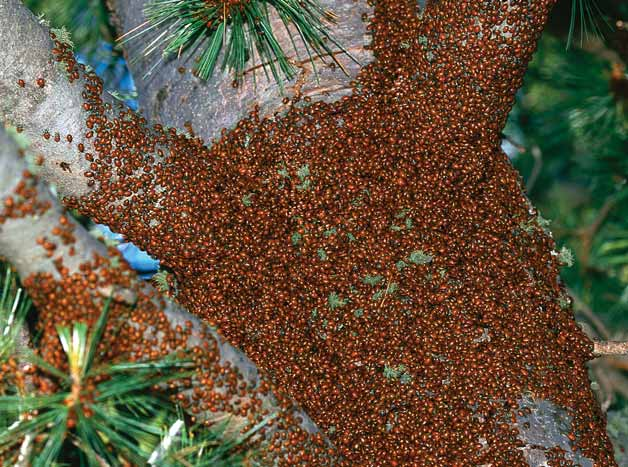A Gathering of Ladybugs

the beetles take cover under a blanket of snow that offers some insulation against killing deep freezes that would destroy those fully exposed to the mountain air. The beetles sit in the dark, thoroughly chilled, their metabolisms shut down, their bodies conserving valuable energy and water until the spring arrives.eggs. When the larval ladybirds hatch, they look like miniature Gila monsters as they crawl along stems, chomping through one aphid after another.
A beetle lands on me and I brush it off. The insect responds by releasing a sharp acrid odor.
The unpleasant smell of ladybirds is really an advertisement of the fact that they contain assorted defensive chemicals, among them toxic alkaloids that induce illness and vomiting in animals unwise enough to ingest them. I am not tempted to snack upon the beetles, but some birds and ants eat a wide range of insects, which has led to the evolution of toxicity and warning odors and colors in a host of potential prey.
The ladybirds of Arizona's mountains come out of suspended animation with the advent of warmer temperatures, which melts the snowpack. The beetles bask in the sun before lifting their bright wing covers and exercising their leathery wings, which carry them away from their high elevation "hibernation" sites and downslope to places where they can find aphids and other small insects to eat and places where they can lay [LEFT] Ladybird beetles, also called ladybugs, serve farmers and gardeners by consuming large volumes of aphids and other plant pests. During the Middle Ages, they were thought to be a gift from the Virgin Mary, hence the name ladybird.
The fondness of many ladybirds, young and old alike, for aphids and other agricultural pests has led to the wholesale capture of adults by entrepreneurs eager to sell the beetles as aphid-eaters to commercial and suburban gardeners.
Although ladybirds sometimes do what they are asked to, namely to remove as many as 5,000 aphids per beetle from crops or gardens, the released predators often simply take off in search of hunting grounds more to their liking.
We do not need a strictly economic reason to admire the ladybird. It is enough for most of us just to watch these trim little insects as they turn August into Christmas at Barfoot Lookout, painting the pine trees in the cheerful colors of the ladybird.
John Alcock is regents' professor of biology at Arizona State University in Tempe. He studies the behavior of a whole range of Arizona insects and has a warm spot in his heart for the ladybird beetle.
Paul and Joyce Berquist of Tucson were actually looking for butterflies to photograph when they happened upon masses of ladybugs.
GRAND CANYON'S KOLB STUDIO CELEBRATING 100 YEARS OF PHOTOGRAPHY ON THE EDGE
Dramatically situated on the South Rim of the Grand Canyon, the Kolb brothers' historic studio provides a window into the storied lives of two of the Canyon's early pioneers.
[INSET] A wild sense of adventure and a great love of the Grand Canyon marked the Kolb brothers' photographic exploits. EMERY KOLB COLLECTION/CLINE LIBRARY/NORTHERN ARIZONA UNIVERSITY
Already a member? Login ».